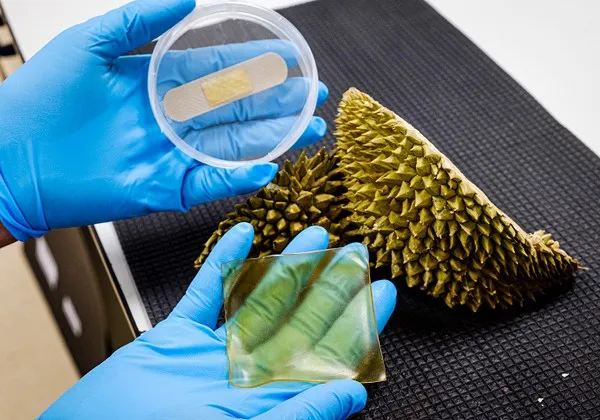Food scientists from Nanyang Technological University, Singapore (NTU Singapore) have made an antibacterial gel bandage using the discarded husks of the popular tropical fruit, durian.
Known as the "King of Fruits" in Southeast Asia, the durian has a thick husk with spiky thorns which is discarded, while the sweet flesh surrounding the seeds on the inside is considered a delicacy.
By extracting high-quality cellulose from the durian husks and combining it with glycerol – a waste by-product from the biodiesel and soap industry – NTU scientists created a soft gel, similar to silicon sheets, which can be cut into bandages of various shapes and sizes.
They then added the organic molecules produced from baker's yeast known as natural yeast phenolics, making the bandage deadly to bacteria.
Developed by Professor William Chen, the Director of NTU's Food Science and Technology Programme, the innovation was published recently in ACS Sustainable Chemistry & Engineering, a peer-reviewed journal of the American Chemistry Society.
Conventional hydrogel patches are commonly available at pharmacies, usually used to cover wounds from surgery to minimise the formation of excessive scar tissue, resulting in a softer and flatter scar. The patch keeps the skin hydrated instead of drying up when conventional band-aid or gauze bandages are used.
Prof Chen said conventional hydrogel patches on the market are made from synthetic materials such as polymers like polymethacrylate and polyvinylpyrrolidine. Those with antimicrobial properties also use metallic compounds such as silver or copper ions. Such synthetic materials approved for use in biomedical applications are more costly as compared to the new hydrogel made from natural waste materials.
"With the growing threat of antibiotic-resistant superbugs, the world will need multiple alternative ways to prevent infections. An effective way to protect open wounds is with antimicrobial bandages that are biocompatible and safe for prolonged use by humans. This is especially important for diabetic patients suffering from chronic wounds," explained Prof Chen, the Michael Fam Chair Professor in Food Science and Technology at the School of Chemical and Biomedical Engineering.

Gel works even at freezing temperatures and contains natural antimicrobial compounds derived from yeast
"By using waste products which are currently discarded in large quantities – durian husks and glycerol – we could turn waste into a valuable biomedical resource that can enhance the speedy recovery of wounds and to reduce chances of infections.
With the husk comprising 60 per cent of the durian it is usually discarded and incinerated, posing an environmental issue. In Singapore, it was reported by The Straits Times that 14,300 tonnes of durian (estimated 10 million durians) were imported and consumed in 2017.
Being non-toxic and biodegradable, the organic gel bandage is also expected to have a smaller environmental footprint than conventional synthetic bandages.
For more information:
Lester Kok
Nanyang Technological University
Email: lesterkok@ntu.edu.sg
